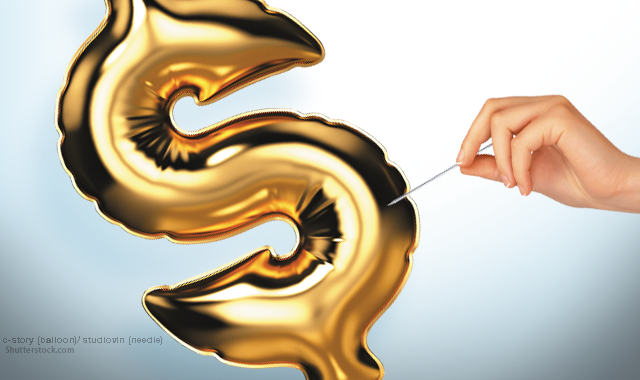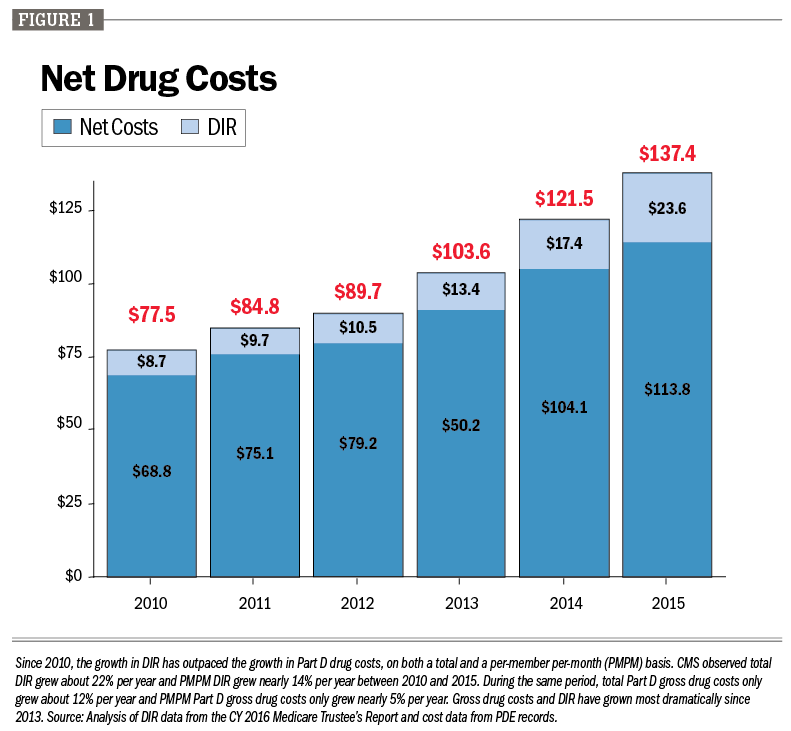Everything Pharmacists Need to Know About DIR Reform
Meaningful changes to DIR fees are on the horizon-will pharmacies see an increase in reimbursements?

Direct and indirect remuneration (DIR) fees are the bane of many pharmacists’ lives. Now, changes may be coming. At last.
“DIR fees have been disastrous for community pharmacy in part because of how much money they are clawing back, but just the uncertainty, the unpredictability of it is also a problem,” says Bradley J. Arthur, RPh, co-owner of two independent pharmacies in Buffalo, NY, and past president of NCPA. DIR fees originated when Medicare Part D was created in 2006, Arthur says, but the fees charged by plans or pharmacy benefit managers (PBMs) have become more prominent-and more detrimental to pharmacies-in recent years.
On April 3, CMS issued a final 2019 Medicare Part D rule that asserted its authority to require a portion of DIR fees to be assessed at the point of sale. The rule doesn’t actually make the change, but opens the door for further discussion about how the fees are assessed. According to the rule, any formal changes to DIR fees “would be proposed through notice and comment rule-making in the future.”
Related article: Ohio Cracks Down on PBMs
Pharmacy officials see this move as a step in the right direction.
“In this rule, CMS hints strongly that it is concerned about retroactive pharmacy DIR, that it has the statutory authority to address the issue, and that there may be further rule-making to deal with it in the months ahead,” said NCPA CEO B. Douglas Hoey, RPh, MBA, in a release. “That’s very promising. This rule simply telegraphs the next step in the process.”
This change comes months after CMS solicited comments on a suggestion within the proposed 2019 rule that the DIR fees be assessed at the point of sale rather than retroactively.
“We are gaining traction,” says Ronna Hauser, vice president of regulatory affairs for the NCPA.
CMS’ rule change also comes after bills were introduced into the House and Senate in February 2017. These identical bills would bar retroactive DIR fees and improve transparency by requiring that DIR fee assessments be made at the point of sale. Both bills remain active at press time and have earned support from legislators.
Related article: Pharmacists Are the Vitamins of Healthcare
Some in the pharmacy industry are optimistic that these efforts could eliminate retroactive Medicare Part D pharmacy fees that cause reimbursements to shrink well after a sale has been made.
Growing Impact
“I think a lot of folks didn’t fully appreciate the impact of DIR fees until they were up to an amount where it was starting to affect their cash flow,” says Arthur. “If you quietly take a couple hundred bucks from me in a month, it’s probably not going to rise to the level where I am going to react to it, but when it started getting into the thousands and tens of thousands-and I hear of single stores now where it’s $60,000 a year in DIR fees-now you are talking about amounts of money that are deal breakers for some small, single store pharmacies.”
Up next: Increasing fees
Total DIR fees grew about 22% per year since 2010, while the per-member per-month DIR grew nearly 14% per year between 2010 and 2015, according to a 2017 fact sheet from CMS [see Fig. 1.]

Click to expandFor the past two years, NCPA members have identified retroactive pharmacy DIR fees as the top legislative and regulatory priority, with more than 37% choosing the issue as their top concern in 2018.
Kala Shankle, director of policy and regulatory affairs for NCPA, believes one reason the fees are becoming more prevalent is because payers and PBMS are using them to work around the increasing number of state maximum allowable cost (MAC) transparency laws.
MAC lists are created by payers or PBMs and give the upper limit a plan will pay for generic, or brand name drugs that have an available generic. Historically, payers or PBMs have had free rein to pick what’s on their list. Transparency laws seek to clear up how MAC is determined and compel PBMs to provide more information about their MAC list practices.
“It is likely that the plans and PBMs have determined that utilizing DIR reconciliation processes after claim adjudication allows them to keep published MAC amounts high while ultimately reducing the aggregate reimbursement for generic drugs at the end of an established reconciliation period, further obscuring the true reimbursement amounts to pharmacies,” Shankle says.
Business Implications
This obscuring of reimbursement raises problems for chains, specialty pharmacies, and independent pharmacies.
“DIR fees are disconnected in time and this makes it difficult to manage our businesses. When the fees are finally collected, many are not provided with supporting claim detail which makes it difficult to determine if these fees are even accurate,” says Kathy Bryant, RPh, MS, vice president of pharmacy at Price Chopper Supermarkets. “Forecasting them becomes nearly impossible.” Price Chopper Supermarkets operates 86 pharmacies across six states in the Northeast.
Bryant says sometimes the chain does not know how it will be reimbursed for a transaction until three to six months after it occurs. When the reimbursement does arrive, without claim detail, it’s impossible to understand what happened or when it might happen again, she adds.
Related article: Removing DIR Fees Could Save Billions
While DIR fees were originally created under the guise of pay for performance, the reality is very different, she says. “For the majority of plans, no matter how strong our performance is, the DIR fee will not be zero, let alone paying a positive amount for a strong performance.”
The impact of DIR fees can be particularly significant for specialty pharmacy drugs that often carry a high price tag because the reimbursement is often based on a percentage of the drug cost.
“In the specialty field, it is really difficult because you don’t know the amount of take backs, and the percentages can be high enough that it can make you negative in the reimbursement,” says Brian Komoto, PharmD, president and CEO of Komoto Healthcare, a group of pharmacy companies that provides retail pharmacy services.
Komoto says his specialty pharmacy was so challenged by the fees that they had to alter which plans they would accept. “Once we started getting a history of which Part D plans were taking percentages rather than fees, that’s when we said we have to exclude these plans until we know for sure what the upfront DIR fee is,” he says.
NACDS weighed in on DIR fees in January. It sent a letter to CMS after the rule was proposed requesting clarification as to whether it could expect the negotiated price, including all pharmacy price concessions, be used for determining pharmacy reimbursement for prescription drugs at point of sale, or if CMS would expect such a negotiated price to be used solely for determining beneficiary payment at the point-of-sale. NACDS agrees there is a need for greater transparency between part D plans and pharmacies in the use of DIR fees and other post-adjudication fees and quality and performance-based network fees.

Click to expand“[W]e would urge CMS to consider that the negotiated price be used solely for determining beneficiary payment at the point of sale and not for determining pharmacy reimbursement at the point-of-sale,” NACDS wrote in the letter.
Improving the System
Before CMS’s rule change was issued, the agency sought further information on ways in which retroactive pharmacy DIR fees can be assessed at the point of sale.
If the fees were assessed at the point of sale, pharmacies would be able to make better decisions on how they want to structure their business, better understand what impact DIR fees would have on their bottom line as they plan for the future, and make smarter choices regarding what plans to do business with, says Bryant.
Arthur says he’d rather see the fees eliminated completely, but believes assessing the fees at the point of sale is a good starting point. “At least give the pharmacists at the point of sale [an opportunity] to make a decision. Maybe they decide, ‘I just can’t provide this service to you for this high dollar specialty,’” Arthur says. “It’s progress. It’s not the end-all, but it’s progress.”
A positive benefit resulting from the fight against DIR fees is that it’s uniting pharmacists, says Bryant. “We are all here to serve our patients, that’s why we do what we do, so this really has us joining together in one voice in proposing and soliciting help on something that can help us, but ultimately help our patients.”
While DIR changes are gaining momentum, experts believe meaningful change isn’t imminent. CMS has opened the door to further discussion on this issue through this rule change, but a more formal comment period and discussion are likely to follow.
“That’s where you are going to see the real regulatory knives come out,” Shankle says, noting that the biggest opposition will likely come from the PBMs. “They would have to change up some processes in the way that they do things.”
In the interim, experts say pharmacists can help continue to increase momentum in both the regulatory and legislative front by contacting their senators and representatives and sharing their stories about DIR fees and the challenges they pose.
